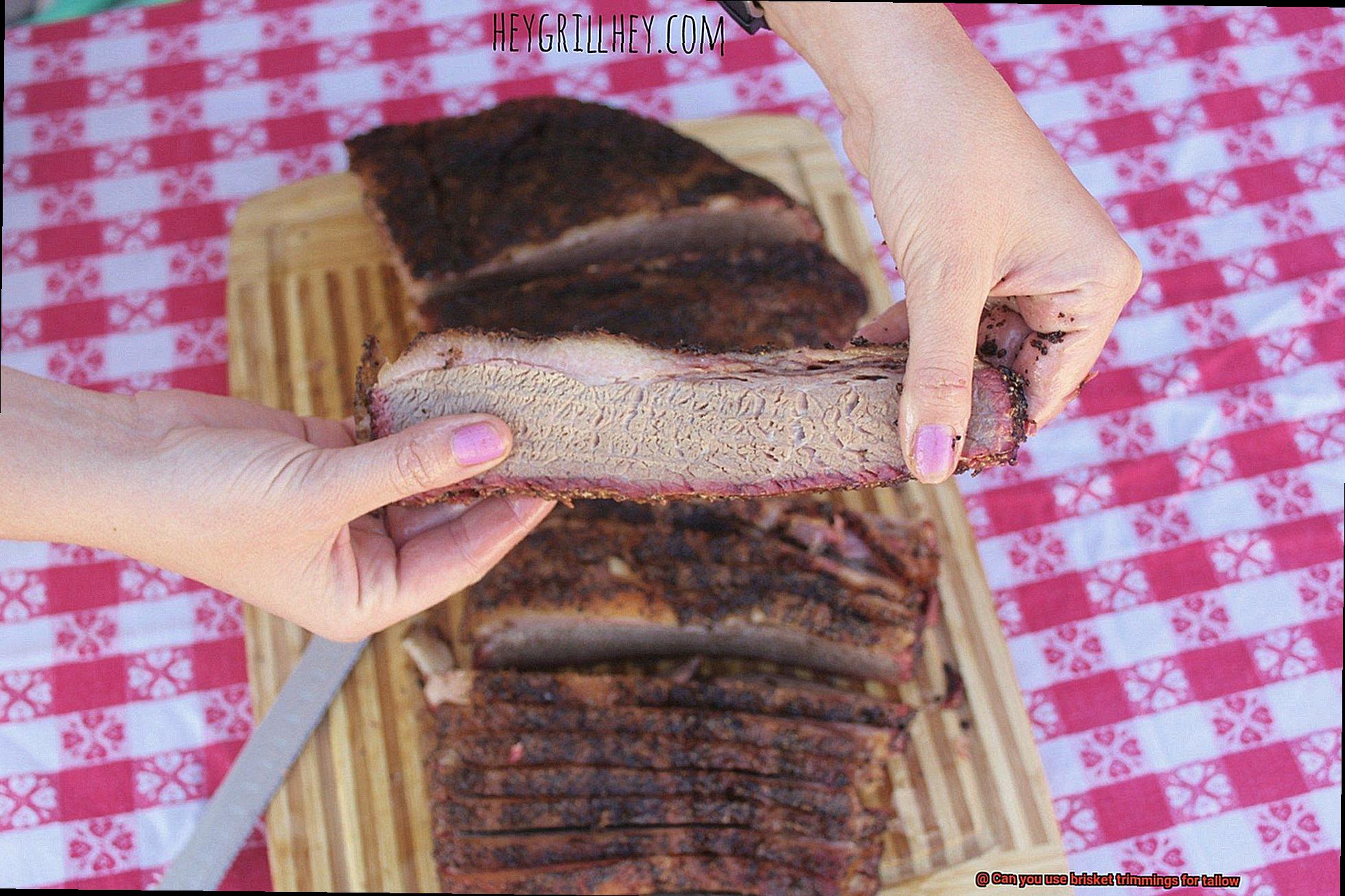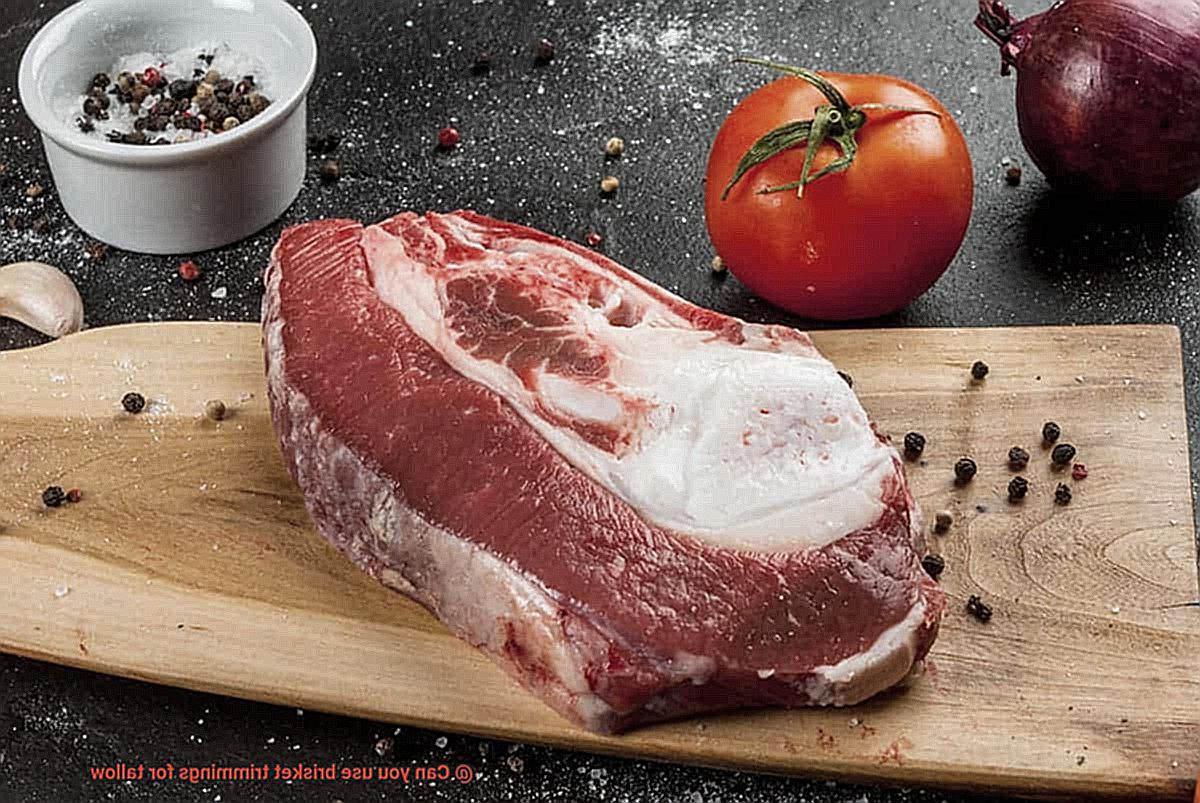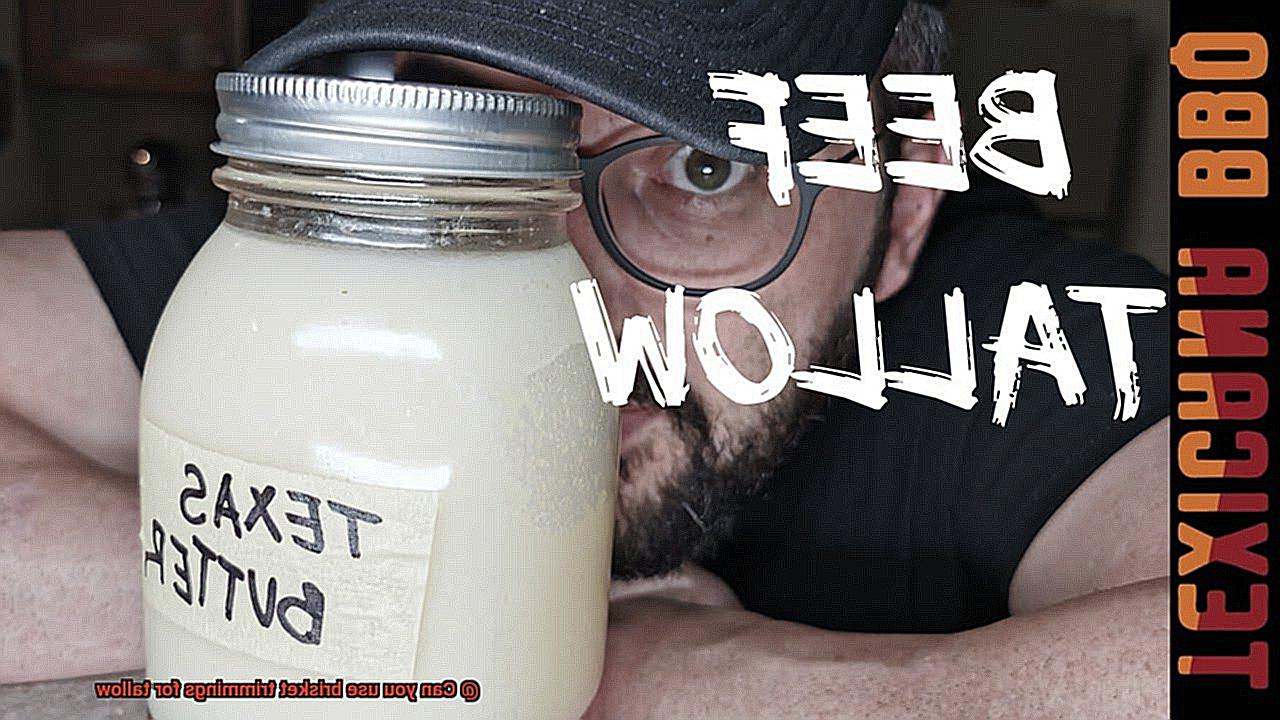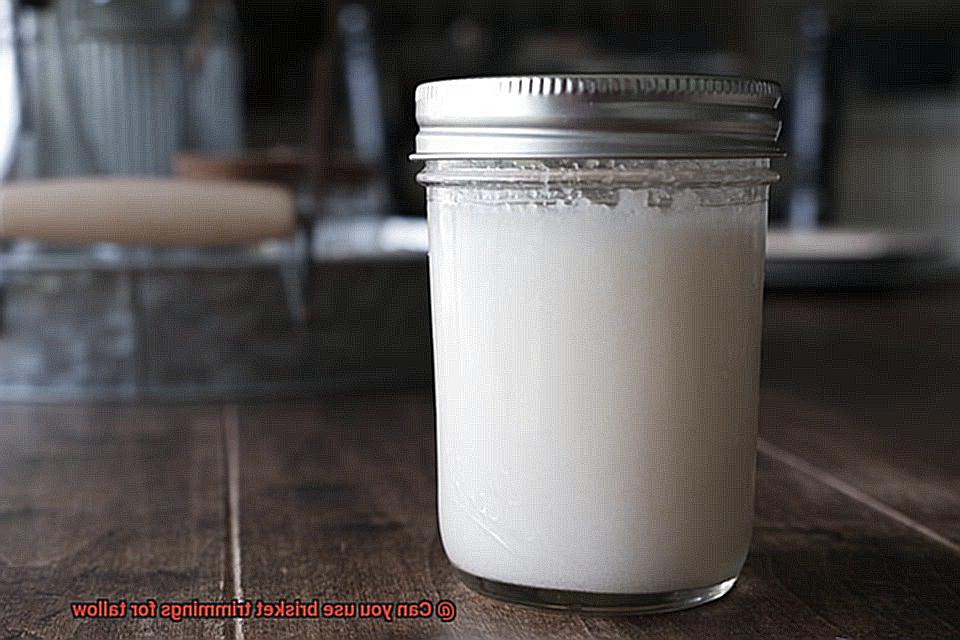Do you love the succulent taste of brisket? Well, what if I told you that you could turn the trimmings from your brisket into a valuable cooking ingredient? That’s right. Brisket trimmings can be transformed into tallow – a highly sought-after ingredient in culinary circles.
In case you’re not familiar with tallow, it is a common cooking fat derived from animal fat, typically beef or sheep. Tallow has been used in cooking for centuries and has recently made a comeback due to its many benefits. It is an adaptable ingredient that can be used for frying, baking, and even candle making.
But let’s get back to the brisket trimmings. Can they really produce tallow? The answer is yes. While the amount of fat will vary depending on the brisket, most briskets have a decent amount of fat content. By rendering the fat, you can extract the tallow and use it in your cooking.
Using brisket trimmings to make tallow is also cost-effective compared to buying it outright. Plus, you’ll be able to use every part of your brisket while reducing waste in your kitchen.
In this blog post, I’ll guide you through how to render tallow from brisket trimmings, highlight the benefits of using tallow in your cooking, and offer some mouth-watering recipes to try with your newfound ingredient. Get ready to elevate your brisket game.
Contents
What is Tallow?
Have you ever wondered what tallow is? Tallow is a type of rendered fat that has been utilized for centuries in cooking and skincare. It is typically derived from the fat of cows, sheep, or deer, and its numerous uses make it a versatile and valuable substance.
One of the primary uses of tallow is in cooking. With its high smoke point, tallow can be heated to high temperatures without burning or smoking. This makes it perfect for frying and sautéing, and it also adds a distinct flavor to dishes.
To produce tallow, animal fat is melted down and filtered to eliminate impurities. The outcome is a hard, white substance that can be used in several ways. Tallow has a long shelf life, making it an excellent option for cooking oils that can be stored for extended periods.
Tallow’s multifaceted nature extends beyond cooking uses as it has also become popular in skincare products. Tallow is rich in essential vitamins such as A, D, E, and K, which are crucial for healthy skin. Skincare products formulated with tallow are said to be highly nourishing and moisturizing for the skin.
Throughout history, tallow has been utilized by various cultures worldwide. Medieval Europeans used tallow to make candles while Middle Easterners utilized it as a base for perfumes. Native Americans relied on tallow as a source of energy during long journeys and as a hair conditioner.
If you want to explore making your own tallow at home, brisket trimmings from grass-fed beef can be used to produce high-quality tallow. It’s best recommended to use premium brisket trimmings for optimal results.
What are Brisket Trimmings?
Brisket is a popular cut of meat used in some of the best barbecue dishes out there. But did you know that there’s more to brisket than just the meat on your plate? Enter brisket trimmings – the little pieces of meat and fat that are trimmed off a whole brisket before it’s cooked.
At first glance, these trimmings may not seem like much, as they may contain excess fat and connective tissue, or may be too small for traditional barbecue recipes. However, don’t throw them away just yet. Brisket trimmings can be repurposed for other uses, such as making tallow.
Tallow is a rendered form of beef fat that has been utilized for centuries in cooking and skincare products. To make tallow from brisket trimmings, the trimmings must be melted down over low heat until all of the fat has been rendered out. While this process can take several hours, it’s worth the effort, as tallow made from brisket trimmings can be used in a variety of recipes.
But why should you bother making tallow from brisket trimmings? For starters, tallow has a high smoke point, making it ideal for frying and sautéing. It also adds a rich flavor to dishes, perfect for adding depth to your cooking. Furthermore, tallow made from brisket trimmings can also be used in skincare products such as soaps and moisturizers. Its high levels of stearic acid and oleic acid make it an excellent emollient that helps to moisturize and protect the skin. Plus, it’s rich in antioxidants and vitamins A and E, which help to reduce inflammation and fight free radicals.
So the next time you’re about to discard those brisket trimmings, think twice. With a little bit of effort, you can transform them into a versatile ingredient like tallow that can be used in a variety of ways. Here are some key takeaways to keep in mind:
How to Make Tallow from Brisket Trimmings
Tallow is a versatile ingredient that has been used for centuries in cooking and skincare. Made from rendered beef fat, it can be a flavorful and healthy addition to your meals and beauty routine. And the best part? You can make it at home using brisket trimmings. Here’s how:
Step 1: Trim the Fat
To make tallow from brisket trimmings, start by trimming away any excess meat or connective tissue from the fat. This will ensure that your tallow is pure and free from impurities. Use a sharp knife or kitchen shears to cut the fat into small pieces.
Step 2: Render the Fat
Next, you will need to render the fat. This involves heating the fat slowly over low heat until it melts and separates from any remaining solids. You can do this on the stovetop or in a slow cooker. Be patient, as this process can take several hours.
Step 3: Strain the Tallow
Once the fat has fully rendered, strain it through a fine mesh strainer or cheesecloth to remove any remaining solids. This will ensure that your tallow is pure and free from any impurities.
Step 4: Allow to Cool and Solidify
After straining, pour the liquid tallow into a container and let it cool and solidify at room temperature. Tallow has a high smoke point, which makes it ideal for high-heat cooking methods like frying and roasting. It also has a long shelf life and can be stored at room temperature for several months.
Step 5: Enjoy the Benefits
Now that you’ve made your own tallow, you can use it in many ways. Try using it as a substitute for butter or oil in cooking and baking recipes. It can also be used in soap-making and other cosmetic products due to its moisturizing properties.
It’s important to note that not all brisket trimmings are suitable for making tallow. Choose trimmings that are relatively high in fat and free from any seasoning or flavorings. Grass-fed beef is generally considered to produce higher quality tallow due to its higher Omega-3 content and lack of added hormones or antibiotics.

Benefits of Using High-Quality Brisket Trimmings for Tallow

If you’re a fan of cooking with tallow or using it in your skincare routine, you know that the quality of the beef trimmings used can make all the difference. That’s why using high-quality brisket trimmings for tallow is a game-changer.
First and foremost, brisket trimmings are typically very fatty, which means they yield a lot of tallow when rendered. This makes them a cost-effective option for those who want to make homemade tallow without breaking the bank. Plus, with more tallow to work with, you can get creative in the kitchen and experiment with different recipes.
But it’s not just about quantity – using high-quality brisket trimmings for tallow can also result in a more flavorful end product. Brisket is known for its rich, beefy flavor, and this flavor is infused into the tallow during the rendering process. This can add depth and complexity to dishes that are cooked with the tallow, making them even more delicious.
Moreover, brisket trimmings are often easier to source than other types of beef trimmings. Brisket is a popular cut of meat in many parts of the world, which means that there is often an abundance of trimmings available for purchase. This makes it easy for home cooks and chefs alike to get their hands on the ingredients they need to make high-quality tallow.
Different Uses for Tallow
Tallow is a rendered fat obtained from beef or mutton and has a variety of uses that go beyond just cooking. Let’s explore some of the different uses for tallow.
Firstly, tallow is an excellent cooking ingredient. Its high smoke point makes it perfect for high-temperature cooking methods such as frying and roasting. It can also be used as a substitute for butter or oil in baking recipes, making it a healthier option for those looking to cut down on saturated fats.
But tallow is not limited to the kitchen. It is also a key ingredient in traditional soap making. Adding hardness and lather to the soap, tallow makes it last longer and is gentle on sensitive skin. If you’re looking for a natural and effective soap option, tallow soap is worth considering.
Did you know that before electricity was invented, tallow candles were widely used? They burn brighter and longer than other types of candles, making them ideal for outdoor activities such as camping. The warm glow of candlelight can add a cozy ambiance to any setting.
If you’re into leather goods, tallow plays a significant role in leather making. It softens the leather, making it more pliable and waterproofs it, making it suitable for outdoor wear. Tallow is an excellent natural alternative to synthetic chemicals typically used in leather production.
Lastly, tallow can be used in cosmetic products such as lip balms and moisturizers due to its moisturizing properties. It is an effective ingredient that can help keep your skin hydrated and healthy.
Storing and Preserving Tallow
If you’re using it for cooking, soap making, or even cosmetic products, you want your tallow to stay fresh and flavorful. Here are some simple and effective techniques to keep your tallow in top condition.
Store in a cool, dry place
Tallow can be stored at room temperature, but it’s best to store it in a cool, dry place. This will help prevent oxidation and extend its shelf life. To ensure it stays fresh, keep it away from heat and direct sunlight.

Divide into smaller portions
If you have a large amount of tallow, consider dividing it into smaller portions. This makes it easier to use and less likely to spoil. You can store the portions in airtight containers or wrap them in plastic wrap before putting them in the fridge.
Freeze for long-term storage
You can also freeze tallow for long-term storage. Pour melted tallow into an ice cube tray and freeze until solid. Once frozen, transfer the cubes to a freezer-safe container or bag and store in the freezer for up to 6 months.
Use clean utensils and equipment
Maintaining the quality of tallow requires keeping it free from moisture and contaminants. Any water or impurities that get into the tallow can accelerate spoilage and affect its flavor and texture. Therefore, it’s crucial to use clean utensils and equipment when handling tallow.
Common Mistakes to Avoid When Making Tallow
Avoiding common mistakes is key to ensuring that you end up with a high-quality, desirable end product. Here are some tips and tricks to help you avoid these mistakes and achieve the best possible results.
Firstly, it’s important to properly prepare the brisket trimmings before rendering. Removing any excess fat or meat from the trimmings before rendering them is crucial. Failing to do so can result in tallow that has a strong beefy smell and can also make the rendering process more difficult than it needs to be.
Another common mistake is not rendering the tallow for long enough. For best results, tallow should be rendered until it is fully melted, with no solid pieces left. If you’re not patient enough, or if you don’t render the tallow for long enough, it may not have a smooth consistency, making it difficult to work with.
Using low-quality or contaminated trimmings is another mistake that many people make. To avoid this, be sure to use high-quality, fresh trimmings that have been properly stored and handled. Using contaminated trimmings can result in tallow that is not safe for consumption, which is something that you definitely want to avoid.
Lastly, proper straining of the tallow is crucial. Strain the tallow through a fine mesh strainer to remove any impurities or solid pieces. This will help ensure that the tallow is smooth and of high quality.
Alternatives to Making Tallow from Brisket Trimmings
When it comes to cooking with brisket, there’s no denying that the meat is mouthwateringly delicious. However, what many people don’t know is that the trimmings from your brisket can also be used in a variety of creative ways. While making tallow is a common way to make use of these trimmings, there are certainly other options for those who don’t have access to the necessary equipment or simply prefer alternative methods.
Here are three alternatives to making tallow from brisket trimmings that you might want to consider:
Make Beef Broth or Stock
If you love to cook and want to get the most out of your brisket, consider using the trimmings to make beef broth or stock. This method involves simmering the trimmings with water, herbs, and vegetables for several hours until a rich and flavorful broth is created.
The broth can then be used in soups, stews, and sauces, or even enjoyed on its own as a comforting drink. Not only is this alternative delicious, but it also helps reduce food waste by using all parts of the animal.
Create Beef Fat or Suet
Another option for utilizing brisket trimmings is to create beef fat or suet. This can be used in cooking and baking, adding flavor and moisture to your dishes. To do this, simply render the fat by heating the trimmings in a pot over low heat until the fat has melted and separated from any remaining solids. Strain the mixture through a cheesecloth and store in an airtight container. You can then use this beef fat in place of butter or oil in your recipes.
Donate to Local Farmers or Ranchers
For those who aren’t interested in using their brisket trimmings for cooking purposes, donating them to a local farmer or rancher is a sustainable option that helps eliminate food waste while supporting local agriculture. Livestock farmers often use trimmings as feed for their animals, making this an eco-friendly alternative that benefits everyone in the community.
hu4kpG15EtQ” >
Conclusion
In conclusion, don’t let those brisket trimmings go to waste. Transform them into something truly special and versatile – tallow. This ingredient has been used for centuries in cooking and beyond, and is highly sought-after by culinary enthusiasts.
To make tallow from brisket trimmings, it’s important to start by trimming away any excess meat or connective tissue from the fat. Then, slowly render the fat over low heat until it melts and separates from any remaining solids. Once fully rendered, strain it through a fine mesh strainer or cheesecloth to remove any remaining solids and allow it to cool and solidify at room temperature.
Using high-quality brisket trimmings for tallow can result in a more flavorful end product that adds depth and complexity to dishes. Plus, it’s a cost-effective option compared to buying tallow outright – perfect for home cooks looking to experiment with new recipes.
But tallow isn’t just useful in the kitchen. It can also be used for soap-making, candle-making, leather goods production, and skincare products due to its moisturizing properties. And when storing tallow, remember to keep it in a cool dry place or divide it into smaller portions before freezing for long-term storage.
If making tallow isn’t your thing, there are still other options available. Consider making beef broth or stock with the trimmings or donating them to local farmers or ranchers.






